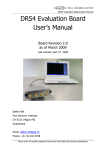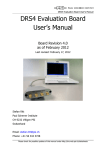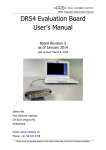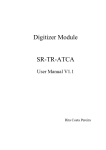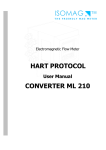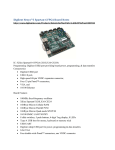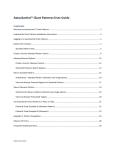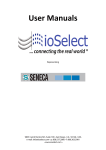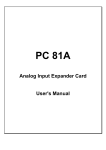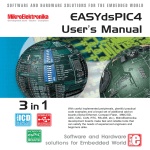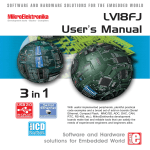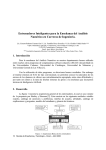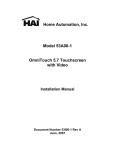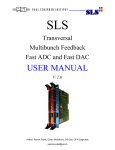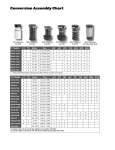Download Rev. 1.1 manual - Paul Scherrer Institut
Transcript
DRS4 Evaluation Board User’s Manual DRS4 Evaluation Board User’s Manual Board Revision 1.1 as of Dec. 2008 Last revised: Dec. 15, 08 Stefan Ritt Paul Scherrer Institute CH-5232 Villigen PSI Switzerland Email: [email protected] Phone: +41 56 310 3728 Please check for possible updates of this manual under http://drs.web.psi.ch/datasheets DRS4 Evaluation Board User’s Manual Revision History Date Modification 12 Dec. 08 Initial Revision 15 Dec. 08 Added firmware register mapping Page 2 of 21 DRS4 Evaluation Board User’s Manual Table of Contents Revision History......................................................................................................................... 2 Table of Contents ....................................................................................................................... 3 1. 2. 3. 4. Introduction ....................................................................................................................... 4 1.1. Board description ..................................................................................................... 4 1.2. Firmware Description............................................................................................... 5 Installation......................................................................................................................... 7 2.1. Windows XP ............................................................................................................ 7 2.2. Linux ...................................................................................................................... 11 Development Hints.......................................................................................................... 14 3.1. Power Supply ......................................................................................................... 14 3.2. Analog Input........................................................................................................... 15 3.3. Control Voltages .................................................................................................... 15 3.4. ADC Clock............................................................................................................. 15 DRS4 Evaluation Board Schematics............................................................................... 16 Please check for possible updates of this manual under http://drs.web.psi.ch/datasheets DRS4 Evaluation Board User’s Manual 1. Introduction The DRS4 chip, which has been designed at the Paul Scherrer Institute, Switzerland by Stefan Ritt and Roberto Dinapoli is a Switched Capacitor Array (SCA) capable of digitizing eight channels at sampling speeds up to 6 GSPS. This chip is available through the PSI technology transfer program for other institutes and organizations. In order to simplify the design process to integrate the DRS4 chip into custom electronics, an evaluation board has been designed, which demonstrates the basic operation of the chip. It has SMA connectors for four input channels CH1 to CH4, an USB 2.0 connector and a LEMO trigger input (Figure 1). The board is powered through the USB port and contains an on-board trigger logic. It comes with MS Windows® and Linux drivers and two application programs. It is basically equivalent to a four channel 5 GSPS digital oscilloscope. This manual describes the software installation, the usage of the application programs, and gives hints for developers seeking to build new electronics around the DRS4 chip. 1.1. Board description Since the DRS4 chip has differential inputs, the board uses four transformers (ADT1-1WT from Mini-Circuits®) to converted the 50-Ohm terminated single ended inputs into differential signals. The transformers are followed by analog switches (ADG936 form Analog Devices®). These switches allow the multiplexing of the DRS4 inputs between the input connectors and a reference voltage generated by the on-board 16-bit DAC for calibration purposes. The DRS4 is read out by a 14-bit ADC (AD9245 from Analog Devices®) and a FPGA (Xilinx® Spartan 3). The USB connection is implemented with a micro controller (Cypress® CY2C68013A). The high speed modus of the USB 2.0 bus allows for data transfer rates of more than 20 MB/sec. Figure 1: Picture of the DRS4 Evaluation Board with different components Page 4 of 21 DRS4 Evaluation Board User’s Manual For trigger purposes, a 50-Ohm terminated TTL compatible input is implemented (Lemo connector). A on-board discriminator with programmable level allows for self triggering on any of the four input channels. An 1 MBit EEPROM (25LC1025 from Microchip®) is used to store the board serial number and calibration information. Two 14-pin headers carry all important logical signals which allow easy debugging with a logic analyzer or oscilloscope. A JTAG adapter can be used to update the FPGA firmware through a Xilinx® Platform Cable Adapter. 1.2. Firmware Description Both the Windows and the Linux distribution contain a subdirectory “firmware” which contains the FPGA and Microcontroller firmware for the DRS4 Evaluation Board. The FPGA firmware is written in pure VHDL, thus making it easy to port it to other FPGA devices such as Altera® or Lattice®. Only a few Xilinx® basic components such as clock managers and I/O blocks have been instantiated and must be adapted when another FPGA manufacturer than Xilinx® is chosen. The FPGA source code is contained in several files with following contents: src/drs4_eval1.vhd Top level entity. Routing of clock signals, global reset signal, LEDs and LEMO input src/drs4_eval1_app.vhd Main file containing state machines for DRS4 readout, serial interface to DAC, EEPROM and temperature sensor, trigger logic and reference clock generation src/usb_dpram.vhd Instantiates block ram for waveform storage src/usb_racc.vhd Interface to CY2C68013A microcontroller in slave FIFO mode. Implements a set of status and control registers through which the main application can be controlled src/usr_clocks.vhd Generates 66 MHz, 132 MHz, 264 MHz and a phase shifted 66 MHz clock out of the 33 MHz quartz input frequency via the Xilinx® Digital Clock Managers (DCM) ucf/drs4_eval1.ucf Constraint file. Assigns package pins and defines clock constraints 3s400/drs4_eval1.ise Xilinx® ISE 9.2i project file 3s400/drs4_eval1.bit Compiled firmware image directly for Spartan 3s400 FPGA 3s400/drs4_eval1.mcs Compiled firmware image for FPGA EEPROM XCF02S 3s400/drs4_eval1.ipf Xilinx® Impact project file to program FPGA via download cable The firmware for the USB microcontroller from Cypress® is written in C and must be compiled with the Keil® 8051 C compiler. It contains the standard include and library files from the Cypress EZ-USB® development kit plus some DRS specific files: CY7C68013A/drs_eval.c Main micro controller firmware file CY7C68013A/dscr.a51 USB descriptor tables CY7C68013A/drs_eval.hex Compiled firmware file (Intel HEX format) Please check for possible updates of this manual under http://drs.web.psi.ch/datasheets DRS4 Evaluation Board User’s Manual CY7C68013A/drs_eval1.iic Compiled firmware file (For Cypress EZ-USB Console download) CY7C68014A/* Remaining files are standard files from EZ-USB development kit The FPGA firmware implements a set of control and status registers, through which the DRS4 can be controlled and read out. The mapping of the control registers is as follows: # 0 0 0 0 0 0 0 0 0 0 0 0 0 1 1 2 2 3 3 4 4 5 5 5 5 6 6 Ofs. 0x00 0x00 0x00 0x00 0x02 0x02 0x02 0x02 0x02 0x02 0x02 0x02 0x02 0x04 0x06 0x08 0x0A 0x0C 0x0E 0x10 0x12 0x14 0x14 0x16 0x16 0x18 0x1A Bit 0 1 2 3 18 19 21 22 23 24 25 27 28 31..16 15..0 31..16 15..0 31..16 15..0 31..16 15..0 31..24 23..16 7..4 3..0 31..16 15..0 Name start_trig reinit_trig soft_trig flash_trig led tcal_en transp_mode enable_trigger readout_mode neg_trigger acalib dactive standby DAC0 DAC1 DAC2 DAC3 DAC4 DAC5 DAC6 DAC7 configuration channel_config first_chn last_chn trigger_delay sampling_freq Comment write a "1" to start the domino wave write a "1" to stop & reset the DRS chip write a "1" to stop the DRS chip & read the data to RAM Flash contents of RAM into EEPROM 1=on, 0=blinks once at beginning of DRS chip readout switch on (1) / off (0) 264 MHz calib. sig. for DRS chips 1=send DRS inputs to outputs ("transparent mode") write a "1" to enable hardware trigger 0:start from first bin, 1:start from domino stop 1=trigger on high to low transition write "1" to enable amplitude calibration 0:stop domino wave during readout, 1:keep it running 1: put chip in standby mode Set DAC 0 (=A, ROFS) Set DAC 1 (=B, CMOFS) Set DAC 2 (=C, CAL-) Set DAC 3 (=D, CAL+) Set DAC 4 (=E, BIAS) Set DAC 5 (=F, TLEVEL) Set DAC 6 (=G, O-OFS) Set DAC 7 (=H, -) Bit0: DMODE, Bit1: PLLEN, Bit2: WSRLOOP 1=1x8k,0x11=2x4k,0x33=4x2k,0xFF=8x1k first channel address to read out (0..9) last channel address to read out (1..9) trigger delay in ticks of roughly 0.56 ns sampling frequency in ticks (=1024/fsamp*0.120-2) While the mapping of the status registers is like this: # Ofs. Bits 0 0 0 1 2 8 9 9 0x00 0x02 0x02 0x04 0x08 0x20 0x24 0x26 31..16 15..8 7..0 0 31..16 31..16 31..16 15..0 Page 6 of 21 Name board_magic board_type drs_type running stop_cell temperature serial_cmc version_fw Comment 0xC0DE, Magic number for DRS board identification 5 for DRS4 USB Evaluation Board 1.1 4 for DRS4 "1" while domino wave running or readout in progress position of cell where sampling stopped at last trigger temperature in 0.0625 deg. C units Serial number CMC board firmware version (SVN revision) DRS4 Evaluation Board User’s Manual All registers are implemented as 32-bit registers, so they can be mapped easily into some VME address space for example if one decides to build a VME board containing the DRS4. 2. Installation 2.1. Windows XP Under MS Windows® it is important to install the necessary driver before connection the DRS4 Evaluation Board with the PC. The current distribution can be downloaded from http://drs.web.psi.ch/download . The Windows version contains a single program drsxx.exe (where xx is the version) which can be executed to install the driver, applications, documentation and source code. Executing this file starts the installer: You can select which components to be installed: Please check for possible updates of this manual under http://drs.web.psi.ch/datasheets DRS4 Evaluation Board User’s Manual Then you can select the installation directory: After the installer has finished, you can connect the DRS4 Evaluation Board to the Computer: Now you will see the “Found New Hardware” dialog: Where you can click “Install the software automatically” and then click “Next”. Page 8 of 21 DRS4 Evaluation Board User’s Manual After successful installation of the driver, you will see the following window: And a new group in your Start Menu: Clicking on „DRS Command Line Interface“ will start a simple application which connects to the DRS4 Evaluation Board. If it finds the board, it displays the board serial number and the firmware revision as on the following screen shot: Now you are ready to issue your first command “info” which shows some more information, like the current board temperature. The temperature sensor is on the bottom side just below the DRS4 chip. If you keep issuing “info” commands and touch that sensor with your finger, you should see the temperature increase. Please check for possible updates of this manual under http://drs.web.psi.ch/datasheets DRS4 Evaluation Board User’s Manual The second application is an oscilloscope-like program, which connects to the DRS4 board and works pretty much like a normal oscilloscope. You can select the trigger mode, trigger level and trigger source. On Rev. 1.1 of the DRS4 evaluation board, only CH1 can be selected as trigger source. You enable a channel by clicking on the number “1” to “4”. There are two cursors and a few utilities. You can save a waveform in an ASCII format. After you opened a file, each trigger will write the waveform of the active channel(s) to that file. When you are continuously running, the file will grow very quickly. The picture above shows an un-calibrated evaluation board, which shows a noise level of about 7 mV RMS. Future version of the firmware and drivers will contain calibration routines, which bring down the noise by more than one order of magnitude. Page 10 of 21 DRS4 Evaluation Board User’s Manual For test purposes, an internal 240 MHz referenc clock signal can be connected to channel #4 via the “Config” menu: This application will be constantly updated, so please check for updates regularly on the DRS web site. 2.2. Linux The drivers and applications are distributed for Linux in source code and must be compiled on each system. First untar the tar ball: [/usr/local]$ tar -xzvf drs-1.0.tar.gz drs-1.0/ drs-1.0/doc/ drs-1.0/doc/DRS4_rev06.pdf drs-1.0/doc/manual.pdf drs-1.0/include/ drs-1.0/include/ConfigDialog.h drs-1.0/include/DOFrame.h drs-1.0/include/DOScreen.h . . . Then change the directory and do a „make“. Note that to compile the oscilloscope application it is necessary to have the wxWidgets package version 2.8.9 or later installed. You can obtain this package in source form from http://www.wxwidgets.org/downloads/. If this package is present, you can change to the drs directory and issue a make: [/usr/local]$ cd drs-1.0 [/usr/local/drs-1.0]$ make g++ -g -O2 -Wall -Wuninitialized -fno-strict-aliasing -Iinclude -DOS_LINUX Please check for possible updates of this manual under http://drs.web.psi.ch/datasheets DRS4 Evaluation Board User’s Manual -DHAVE_LIBUSB -c src/musbstd.c g++ -g -O2 -Wall -Wuninitialized -fno-strict-aliasing -Iinclude -DOS_LINUX -DHAVE_LIBUSB -c src/mxml.c ... Now you can connect the DRS4 board to the PC. On systems where the “lsusb” tool is installed, one should be able to find the DRS4 evaluation board after connecting it with following command: [/usr/local/drs-1.0]$ /sbin/lsusb -d 04b4:1175 –v Bus 005 Device 005: ID 04b4:1175 Cypress Semiconductor Corp. Device Descriptor: bLength 18 bDescriptorType 1 bcdUSB 2.00 bDeviceClass 0 (Defined at Interface level) bDeviceSubClass 0 bDeviceProtocol 1 bMaxPacketSize0 64 idVendor 0x04b4 Cypress Semiconductor Corp. idProduct 0x1175 bcdDevice 0.01 iManufacturer 1 S. Ritt PSI iProduct 2 DRS4 Evaluation Board iSerial 3 REV1 bNumConfigurations 1 Configuration Descriptor: bLength 9 bDescriptorType 2 wTotalLength 46 bNumInterfaces 1 bConfigurationValue 1 iConfiguration 0 bmAttributes 0x80 MaxPower 500mA ... If the board is correctly recognized, one can access it with the command line program. Under most Linux distributions however, only the “root” user can directly access USB devices. Some systems can be configured to allow non-root access via the “udev” system, but the exact instructions vary from distribution to distribution and can therefore not be given here. [/usr/local/drs-1.0]$ ./drscl DRS command line tool, Revision 12949 Type 'help' for a list of available commands. Found mezz. board 0 on USB, serial #2006, firmware revision 10901 B0> The same commands as in the Windows version can now be entered such as the “info” command: B0> info ============================== Mezz. Board index: 0 DRS type: DRS4 Board type: 5 Serial number: 2006 Firmware revision: 10901 Page 12 of 21 DRS4 Evaluation Board User’s Manual Temperature: Status reg.: PLL locked Control reg.: DMODE single shot Frequency: 30.8 C 00000002 00000000 0.000 GHz If this works, the oscilloscope application “drsosc” can be started. It will open a X window and show exactly the same functionality as its Windows counterpart: Please check for possible updates of this manual under http://drs.web.psi.ch/datasheets DRS4 Evaluation Board User’s Manual 3. Development Hints The idea behind the evaluation board is to make first steps in using the DRS4 chip, but then develop your own custom electronics around the chip. The first thing to do there is to study carefully the DRS4 data sheet, which can be obtained from http://drs.web.psi.ch/datasheets. Then have a look at the DRS4 Evaluation Board Reference Design, which schematics is supplied at the end of this document. When you start to design your own electronics, there are however some important points, which are not necessarily obvious from the data sheet or from the reference design. These points together with some design tips are explained in this section. 3.1. Power Supply As with any analog design, the quality of the power supply is very important, since it has an influence of the noise level measured by the DRS4 chip. Low noise linear regulators together with the usual decoupling capacitors are recommended for all power supplies. The analog power supply AVDD powers only the domino circuit of the DRS4 chip and directly influences the jitter of the sampling frequency. Long term variations in this power supply (seconds…) are regulated by the on-chip PLL, but high frequency noise in the MHz region leads directly to an increase of the PLL jitter. Therefore the evaluation board contains two separate 2.5V linear regulators for the DRS4 chip, one for the AVDD power and one for the DVDD power. Although the DVDD power is called “digital power”, it powers also the analog output buffers of the DRS4 chip and needs the same good quality than the AVDD power in order to minimize the noise of the board. The DRS4 chip also contains two grounds AGND and DGND. They can be either routed separately on the board and be connected at the power source, or they can be directly connected to an overall dedicated ground plane of the PCB. Tests have been shown that the latter choice gives slightly less noise. The bottom of the QFN76 package of the DRS4 has an exposed paddle connected to the internal DGND. It is recommended that this paddle is matched by a PCB pad of similar size connected to analog ground to achieve the best electrical and thermal performance of the DRS4. The copper plane should have several vias to achieve a good heat dissipation to flow through the PCB as shown in Figure 2: Figure 2: PCB pad under the DRS4 chip Page 14 of 21 DRS4 Evaluation Board User’s Manual These vias should be solder-filled or plugged. The maximum power dissipation of the DRS4 chip is not critical (350 mW), but an improved thermal stability helps the performance of any analog chip. To maximize the coverage and adhesion between the DRS4 and the PCB, the copper plane could be partitioned into several uniform sections, providing several tie points during the reflow process. 3.2. Analog Input If non-differential signals should be digitized with the DRS4 chip, they must be converted into differential signals for the DRS4 inputs. The simplest solution is to connect the IN- inputs to AGND and to connect the signals directly to the IN+ inputs. This method has however the disadvantage that the crosstalk and noise immunity of the DRS4 chip are worsened. The evaluation board uses passive transformers ADT1-1WT from Mini-Circuits® for this purpose. While this is a good solution to reduce the power consumption of the board, such that it can be powered from the USB power (500 mA @ 5V), it has the disadvantage that it reduces the analog bandwidth of the system to about 200 MHz (-3 dB). The reason for this is the dynamic capacitive load of the DRS4 inputs, which must be driven by the signal source. Since the input impedance of the DRS4 becomes very small at high frequencies, the signal height drops if only driven passively. Better performance is achieved with active differential drivers. Tests have been made with the THS4513 from Texas Instruments® giving a bandwidth of 450 MHz and the ADA4937 from Analog Devices® giving 700 MHz. A small bypass capacitor (1pF) in the feedback loop of the buffer adds a high frequency pole, which shows up as a peak in the response function, but then pushes the bandwidth to 750 MHz. The peaking can be reduced by adding a series resistor of a few Ohm between the buffer output and the DRS4 input. The usual design rules like proper termination and matched impedance PCB traces apply as in any high frequency analog design. 3.3. Control Voltages The DRS4 chip requires certain control voltages: ROFS, O-OFS and BIAS. The latter two are generated internally with some default voltage, but can be “overwritten” by an external low impedance source. It is recommended to connect these lines to an external 16-bit DAC, so that the DRS4 input range can be fine-tuned on a board-by-board basis, to compensate for chip variations. The ROFS signal should be driven by a high speed low noise buffer. If this signal would be directly connected to the DAC output, the signal height would change slightly during the chip readout and the measurement would show a varying baseline level. 3.4. ADC Clock There is a very strict relation between the DRS4 output shift register clock SRCLK and the ADC clock (see DRS4 data sheet WAVEFORM READOUT). In order to reduce the noise due to aperture jitter, the phase shift between these two clocks must be fixed and contain very small jitter (~10ps). The easiest way to generate this phase shift is to use the digital clock managers (DCM) in the FPGA, as it is done on the evaluation board Rev. 1.1. Since the DCMs have however an inherent phase jitter of ~150ps, this introduces some noise in form of a baseline variation when sampling a DC signal in the order of up to a few mV. If this becomes a problem, it is recommended to generate the phase shift between these two clocks with a low jitter delay circuit. Please check for possible updates of this manual under http://drs.web.psi.ch/datasheets DRS4 Evaluation Board User’s Manual 4. DRS4 Evaluation Board Schematics 6 3 6 2 4 3 1 2 4 4 2 1 1 6 1Y 6 3 1 1A 2Y 4 VCC 5 6 2 4 2 GND 3 1 3 2A Paul Scherrer Institut Department TEM Lab for Electronics (1414) 5232 Villigen PSI Page 16 of 21 DRS4 Evaluation Board User’s Manual 1 2 5 4 3 Paul Scherrer Institut Department TEM Lab for Electronics (1414) 5232 Villigen PSI Please check for possible updates of this manual under http://drs.web.psi.ch/datasheets DRS4 Evaluation Board User’s Manual 4 3 4 3 4 3 4 3 1 1 1 1 1 2 3 4 CS SO 6 WP SCK 5 VSS SI Paul Scherrer Institut Department TEM Lab for Electronics (1414) 5232 Villigen PSI Page 18 of 21 5 5 5 5 2 2 2 2 DRS4 Evaluation Board User’s Manual Paul Scherrer Institut Department TEM Lab for Electronics (1414) 5232 Villigen PSI Please check for possible updates of this manual under http://drs.web.psi.ch/datasheets DRS4 Evaluation Board User’s Manual 1 2 3 4 A0 A1 6 SCL A2 5 VSS SDA 1 2 3 4 5 6 7 8 9 10 11 12 13 14 15 16 17 18 19 20 21 22 23 24 25 26 27 28 29 30 31 32 33 34 35 36 I/O I/O VCCO I/O I/O I/O I/O I/O GND I/O I/O I/O I/O I/O I/O GND I/O I/O VCCO I/O I/O GND I/O I/O I/O I/O I/O I/O GND I/O I/O I/O I/O VCCO I/O I/O 1 2 3 4 5 6 7 8 9 10 DO VCCJ (NC) VCCO CLK VCCINT TDI TDO TMS (NC) TCK (NC) CF (NC) OE/RESET CEO (NC) (NC) CE GND 20 19 18 17 16 15 14 13 12 11 108 I/O 107 I/O 106 VCCO 105 I/O 104 I/O 103 I/O 102 I/O 101 GND 100 I/O 99 I/O 98 I/O 97 I/O 96 I/O 95 I/O 94 GND 93 I/O 92 I/O 91 VCCO 90 I/O 89 I/O 88 GND 87 I/O 86 I/O 85 I/O 84 I/O 83 I/O 82 I/O 81 GND 80 I/O 79 I/O 78 I/O 77 I/O 76 I/O VCCO 75 I/O 74 I/O 73 Paul Scherrer Institut Department TEM Lab for Electronics (1414) 5232 Villigen PSI Page 20 of 21 144 TDI 143 PROG_B 142 HSWAP_EN 141 I/O 140 I/O 139 GND 138 VCCO 137 I/O 136 GND 135 I/O 134 VCCAUX 133 VCCINT 132 I/O 131 I/O 130 I/O 129 I/O 128 I/O-CLK7 127 I/O-CLK6 126 VCCO 125 I/O-CLK5 124 I/O-CLK4 123 I/O 122 I/O 121 VCCINT 120 VCCAUX 119 I/O 118 I/O 117 GND 116 I/O 115 VCCO 114 GND 113 I/O 112 I/O TMS 111 TCK 110 TDO 109 M1 M0 M2 I/O I/O GND VCCO I/O GND I/O I/O VCCAUX VCCINT I/O I/O I/O-CLK2 I/O-CLK3 VCCO I/O-CLK0 I/O-CLK1 I/O I/O/INIT_B I/O I/O VCCINT VCCAUX I/O GND I/O/DIN VCCO GND I/O I/O I/O DONE CCLK 37 38 39 40 41 42 43 44 45 46 47 48 49 50 51 52 53 54 55 56 57 58 59 60 61 62 63 64 65 66 67 68 69 70 71 72 DRS4 Evaluation Board User’s Manual 3 IN 1 GND OUT 2 OUT 4 1 VIN VOUT 5 2 GND 3 ON/OFF BYP 4 3 IN 1 GND OUT 2 OUT 4 OUT 2 OUT 4 1 VIN VOUT 5 2 GND 3 ON/OFF BYP 4 3 IN 1 GND Paul Scherrer Institut Department TEM Lab for Electronics (1414) 5232 Villigen PSI Please check for possible updates of this manual under http://drs.web.psi.ch/datasheets





















